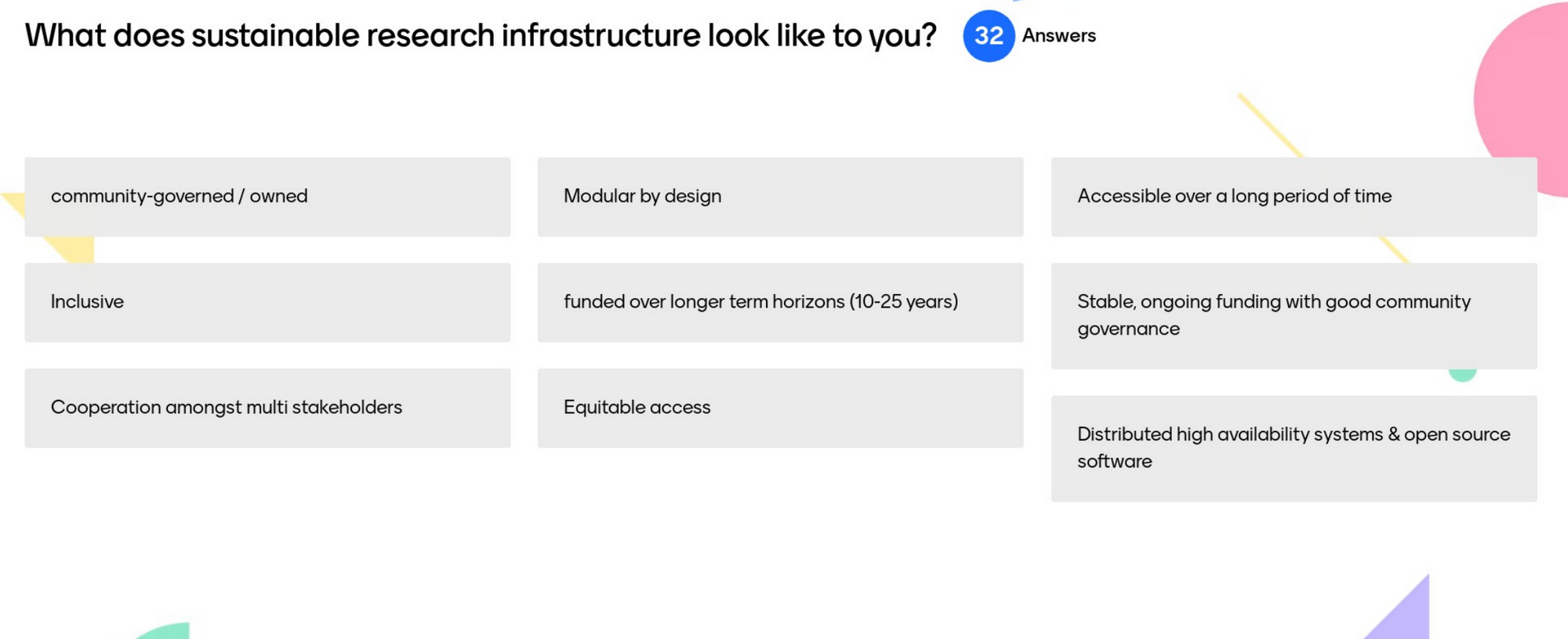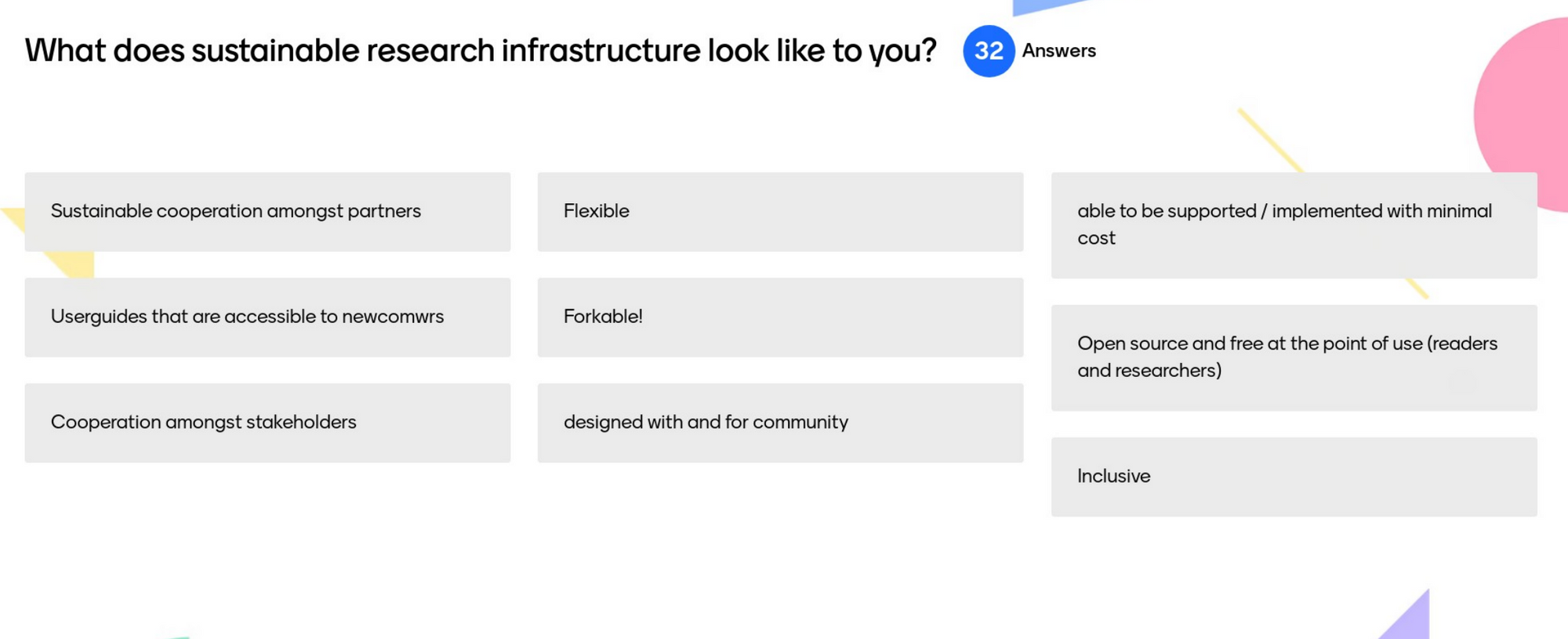According to UNESCO, spending on research and development (R&D) in Africa is estimated at 1% of the continent’s Gross Development Product (GDP). This funding amount is meagre compared to the continent’s diverse R&D needs. Research has the potential to help drive socio-economic growth in Africa. Still, the challenge is that government spending is often prioritised to cater for recurrent expenditure or other development infrastructures like roads, hospitals, schools and agriculture. Private capital is also directed towards research infrastructure to complement government spending, but the shortfall is still significant.
Last month, IOI convened a workshop in Cape Town, South Africa, adjacent to the Open Repositories 2023 conference. The workshop was titled, “Building sustainable research infrastructures in Africa: Exploring public-private partnerships (PPPs).” The premise behind this convening was that research infrastructures (both physical and virtual) are a critical cog in the development puzzle on the continent. Government and private sector synergies can enhance investment in infrastructure and catalyse development on the continent.
The conversation on how we can sustainably fund research infrastructures also directly built on discussions we started with several multi-sectoral stakeholders at the IOI workshop in Accra, Ghana, earlier this year. One of the major takeaways from that conversation was that exploring alternate funding mechanisms is essential to the growth of research on the continent.


Workshop Outcomes
To kick off the discussion, several key players from the for-profit private sector, research, education and not-for-profits gave us their perspectives on PPPs and how their organisations are working to promote investment in infrastructure across the continent. The speakers were:
- Dr Gracian Chimwaza - Chair, the Research4Life Executive Council
- Dr Mmaki Jantjies - Head of Innovation and Transformation, Telkom SA
- Owen Iyoha - CEO, Eko-Konnect; LIBSENSE
- Robert Karanja - Senior Director, Africa, Co-develop
After the interactive presentation segment from the speakers, we ventured into breakout discussions to further unpack how to actualize PPPs in developing research infrastructure in Africa. Below are key takeaways from the meeting:
The ripple effects of public-private sector partnerships in Africa. In examining the PPP models, one of the salient points of the discussion was that there could be other critical benefits that may accrue that are not financial. One crucial area is in terms of talent development. For-profits always want to create a talent pool for their range of ventures. Knowledge transfer via secondment of sponsorship of talent towards capacity-building initiatives. In some instances, private sector entities can for a limited period of time transfer some of their staff to support an initiative that would bring about a bigger impact in the community.
Another key benefit that may be derived from PPPs is in raising awareness around issues and opportunities related to research infrastructure, as a cumulative effect of the government and the private sector leveraging their communications prowess. The combined audience of the government and private sector can ensure that critical information about research infrastructure and consequent opportunities may reach the most significant number of people possible.
Private investment into research infrastructure through PPPs may also facilitate the development of shared physical infrastructure and space for innovation. For example, in Kenya, IBM has invested in a research centre that supports the testing of novel solutions in a range of sectors in collaboration with the government, academia, and startups.
Scale is another ripple effect that results from PPPs. Often you find that the private sector fills gaps that the government needs help to fulfil. By collaborating with the government and private sector, it becomes easier to ensure that the products of investment in research infrastructure can reach the widest number of people. This phenomenon has been witnessed especially in the agriculture, health and telecommunication sectors. In the private sector, there is a lot less bureaucracy so decisions can be made quicker. In contrast with the wide scope of government work, private sector players can hyper specialise in a particular area, and this allows them to have better expertise and resources to catalyse development of ideas. For example, the private sector has largely provided the infrastructural work for fiber optic cable networks in Africa, with the government providing an enabling environment for businesses to invest.
Attracting more for-profit entities to the research space. When it comes to the private sector, it is essential to be aware of the heterogeneity of the sector. There are for-profit entities and social enterprises. For social enterprises, due to how they are structured to support communal progress, engaging and collaborating with them in supporting PPPs for research infrastructure is relatively easy, as long as there is a shared vision.
However, to incentivize for-profit entities to participate in PPPs,, there has to be a clear value add for them. One of the essential points from the discussion is the fact that there is a need to sensitise for-profits on what exactly is meant by research infrastructures. Organisations may need to be entirely aware of the expanse of infrastructures (physical and virtual). This clarity may provide the necessary frame of reference so that for-profits may need to determine their investment in PPPs.
Opportunities for product development may also be a strong incentive for for-profits to engage in PPPs. In some partnerships that support research, some of the products that are developed as a result of the R&D process can eventually be commercialised, and this is a big attraction for for-profits. For example, during the COVID-19 pandemic, there was a lot of collaboration between the government and private sector because the incentive was to come up with medication to halt the spread of the pandemic but also down the line to be commercialised.
However, as we look to encourage collaboration between the private and public sectors, it is important to ensure that private interests do not supersede public investments in community goods and services. Profit making is not bad but when there is an uncontrolled desire to maximise profit at the expense of the public then there is a big ethical challenge. An example where the private sector benefits at the expense of the wider community is in research publication where private entities make billions of dollars in profits from publicly funded research.
PPP Models that work are already in existence in Africa. Participants reflected that in Africa, several existing PPPs are pretty successful and can be modelled. Examples are the Build-Operate-Transfer model, which has been used extensively across Africa in road and railway construction. In this model, private capital is used to finance infrastructure projects, and eventually, on completion, the projects are handed over to the public sector to operate. We look forward to diving deeper into and learning from these models to help inform this work.
What’s Next?
We are sincerely grateful to everyone who participated in and contributed to the rich discussion, and are committed to continue to move this exploration forward. To this end, we are looking to bring together value-aligned private and public sector partners in a next conversation – please reach out to our engagement team (Emmy Tsang at emmy [at] investinopen [dot] org or Jerry Sellanga at jerry [at] investinopen [dot] org if you have ideas or suggestions!